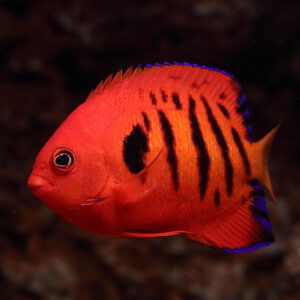Chaoti Leopard Wrasse, Macropharyngodon chaoti, also go by the name Choat’s Red Leopard Wrasse. Like all members of the Macropharyngodon genus, males and females are sexually dimorphic, as they display different colour morphs.
This species looks incredible. Female Chaoti Leopard Wrasse have a white body adorned in warm red scribbles. Red horizontal stripes paint their faces and cut through their eye. Their gill cover also sports a blue spot, which is highlighted in yellow. The younger Leopards have less decoration and a semi-transparent white body. Male Chaoti Wrasse are distinguishable from the females by their face. Alternating orange and green stripes cover their face and frame bright yellow lips.
Macropharyngodon wrasse come from the tropics and are all known as leopard wrasse. The etymology for the genus is ‘big throat teeth’, due to the large molar and canines hidden deep in their throat.
Chaoti Leopard Wrasse, Macropharyngodon chaoti, Ecology.
These fish live in the Western Pacific, around Australia.
They live in diverse areas, such as coral reefs and lagoons, usually with a mixed sand. The complex structures help the wrasse avoid predation. Failing that, Chaoti Leopard Wrasse quickly vanish by burying themselves in the sand bed. These fish feed on shelled plankton, like foraminifera, Arthropods and snails.
Chaoti Leopard Wrasse live in social groups with one dominant male to a few or more females. These fish are protogynous hermaphrodites. Which means when the top male perishes, the largest female in the group will turn male and take its place as boss of the harem. As a result, all juvenile Choat’s Red Leopards are immature females.
Choat’s Red Leopards In the Aquarium.
It is important to copy the natural environment by providing plenty of nooks and crannies. There should also be a good sand bed for the wrasse to hide and sleep in. Hobbyists should get a jump guard to stop any unfortunate losses.
Chaoti Leopard Wrasse do best when fed a varied diet. They will accept enriched frozen mysis shrimp and enriched frozen brine shrimp. They will also devour live foods, such as copepods and amphipods, that can be cultivated in attached refugium. Over time they will accept high-quality pellet or flake. We adapt all our wrasse to aquarium life before they leave us. We focus on their health, and most are eating a good quality flake food and/or pellet, such as JBL Maris, before being offered for sale.





Reviews
There are no reviews yet.